Tangyud Monastery
The Tangyud Monastery (also written bTang-rGyud, Tangyuth) or Sa-skya-gong-mig Gompa[1] at the village of Komic, two km southeast of Hikkim in the Spiti Valley of Himachal Pradesh, India, is built like a fortified castle on the edge of a deep canyon, with massive slanted mud walls and battlements with vertical red ochre and white vertical stripes which make them look much taller than they really are. It is one of the highest altitude gompas (monasteries) in India, at an altitude of 4,520 metres (14,830 ft), on the edge of a deep canyon and overlooking the town of Kaza, Spiti 4 km to the west.[2][3] It is located on the periphery of the Kibber Wildlife Sanctuary.[4]
| བཏང་རྐྱུད་དགོན་པ། Tangyud Monastery | |
|---|---|
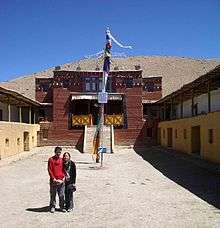 Entrance to Tangyud Gompa, Spiti, 2004. | |
| Religion | |
| Affiliation | Tibetan Buddhism |
| Sect | Drugpa |
| Location | |
| Location | Lahaul and Spiti, Himachal Pradesh, India |
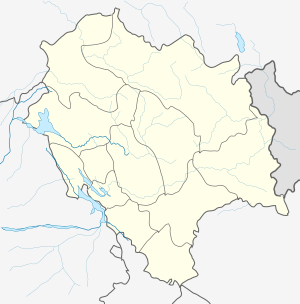 Location within Himachal Pradesh | |
| Geographic coordinates | 32°14′07″N 78°06′40″E |
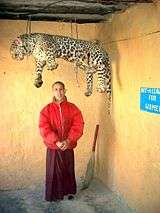
History
It is one of only two monasteries belonging to the Sakya sect left in Spiti - the other, at Kaza itself, is small and relatively insignificant. It reportedly had 60 monks in 1855.[5]
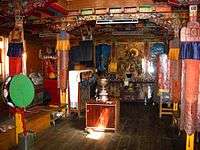
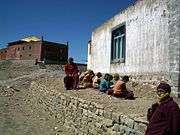
Although it is considered by locals to be very ancient, an examination of the present fortified structure modelled on a Chinese castle, and other circumstantial evidence, makes it likely that it was built early in the 14th century when the Sakyapas rose to power under Mongol patronage.[6]
It is thought, however, that there was an earlier Kadampa establishment here founded by Rinchen Zangpo (958-1055 CE) and named Rador-lha.[7] The name, Tangyud, may refer to the Sakya revision of the Tang-rGyud, or the 87 volumes of Tantra treatises which form part of the Tengyur. This was carried out about 1310 CE by a team of scholars under the Sakya lama, Ch'os-Kyi-O'd-zer.[8]
The monastery is patronised by the 'Nonos' or local chieftains of Spiti and the monastery has a special cell built into southeastern side for them when they visit.[9][10] Tangyud village is at the foot of the monastery (altitude 4,470 m or 14,665 ft). The monastery itself was apparently badly damaged in the earthquake of 1972.[11]
| Part of a series on |
| Tibetan Buddhism |
|---|
 |
|
|
|
Practices and attainment |
|
Institutional roles |
|
History and overview |
Gallery


Footnotes
References
- Francke, A. H. (1914, 1926). Antiquities of Indian Tibet. Two Volumes. Calcutta. 1972 reprint: S. Chand, New Delhi.
- Handa, O. C. (1987). Buddhist Monasteries in Himachal Pradesh. Indus Publishing Company, New Delhi. ISBN 81-85182-03-5.
- Kapadia, Harish. (1999). Spiti: Adventures in the Trans-Himalaya. Second Edition. (1st edition 1996). Indus Publishing Company, New Delhi. ISBN 81-7387-093-4.